We’re celebrating a century of Science News
Across our history, we’ve covered the Scopes trial, the moonwalk, Dolly the Sheep and more

Science News magazine was founded a century ago, in March 1922 as Science News-Letter.
Photo illustration by E. Otwell
- More than 2 years ago
The first three months of covering the COVID-19 pandemic felt, by Tina Hesman Saey’s estimation, “closer to 300 years.” From February to April 2020, the Science News senior molecular biology writer had produced a flurry of stories on the new coronavirus that wove together findings from dozens of scientific papers and reports. Her hours were long and stress levels high. But the science wasn’t slowing down, so neither could she.
“We’re in a hyperdrive situation,” Saey said in May 2020, reflecting on her pandemic reporting. “It’s amazing how fast the science is moving.” In mere months, researchers had completely overhauled their understanding of how the SARS-CoV-2 virus infiltrates the body, and vaccines were already in the works. Readers were counting on Saey and her Science News colleagues to sift through the deluge of information pouring out of labs across the world. “The information that they get from us can really help them make life-or-death decisions,” Saey said.
Since then, Saey and other Science News reporters have cranked out hundreds of stories on SARS-CoV-2’s basic virology, new variants, vaccine rollouts and more. To boost public understanding of the new coronavirus, Science News has freely offered its COVID-19 stories to local and nonprofit news organizations since April 2020.
“What Science News provided was authoritative reporting and in-depth articles on what we’re all talking about and what we’re all worried about,” Cleveland Scene editor in chief Vince Grzegorek said after his publication started reprinting Science News coverage. Whether a story was about the importance of masking up or the riskiness of in-person shopping, Grzegorek said, “what people can read from Science News on our site is going to go a lot further than a 45-second spot on the local [news] station.”
Science News’ push to get reliable reporting in front of as many eyes as possible harks back to before the publication was even a magazine. A little over a century ago, Science News got its start as Science News Bulletin — the first syndicated news specializing in science.
“There certainly had been media coverage of science before,” says Bruce Lewenstein of Cornell University, who studies science communication. But that coverage was more sporadic and often plagued with sensationalism and superstition.
Newspaper magnate Edward W. Scripps, who believed that a functioning democracy required a science-savvy public, wanted to get more accurate, reliable science news in the public eye. To do that, Scripps teamed up with his zoologist friend William E. Ritter to form a new organization for science communication in 1921. Based in Washington, D.C., Science Service — now known as the Society for Science — was funded by Scripps and overseen by a board of 15 scientists and journalists. That board of trustees included famed astronomer George Ellery Hale and Edwin Gay, president of the New York Evening Post.
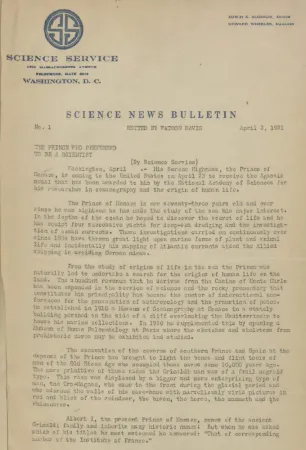
“Science Service was formed at a critical time for science and public understanding of science,” says Susan Swanberg, who studies the history of science journalism at the University of Arizona in Tucson. In the early 20th century, the pace of scientific discovery was making it harder for nonexperts to keep up. At the same time, World War I, nicknamed “the chemists’ war” for the use of chemical weapons on the battlefield, had heightened many people’s uncertainty about, and interest in, science.
Scripps and Ritter hoped their new organization would help bridge the gap between scientists and the public. When Science Service announced its debut in the journal Science in April 1921, the organization branded itself as “a sort of liaison officer between scientific circles and the outside world.” In this go-between role, Science Service hoped to foster popular support for science while helping people become more well-informed citizens. That same month, Science Service launched Science News Bulletin, a weekly — then daily — dispatch of stories to subscribing newspapers across the country. This marked the first sustained effort to provide engaging, accurate news about scientific research to a national U.S. audience.
By October 1921, the bulletin fed more than 30 subscribing newspapers with a combined circulation of more than 1.5 million readers. Libraries, schools and science enthusiasts started requesting copies of the bulletin to keep for themselves. In response, Science Service began bundling its dispatches into a stand-alone publication, dubbed Science News-Letter. Readers got the first issue 100 years ago this month, in March 1922. The publication became Science News in 1966.
Slosson, Scopes and syndication
Science Service’s first editor, Edwin Slosson, fancied himself a “renegade from natural science.” A chemist-turned-writer who had worked as a magazine editor and authored science books, he shared Scripps and Ritter’s belief that democracy hinged on scientific literacy — and that science didn’t need to be overhyped to capture readers’ imaginations.
“It is not necessary,” Slosson wrote in Science News-Letter, “to pervert scientific truths in the process of translation into the vernacular. The facts are sensational enough without any picturesque exaggeration.”
When Slosson took charge of Science Service in 1921, his challenge was not finding interesting science to write about. It was finding journalists to do the writing. Science journalism was a new field. And without an established pool of reporters to call on, Slosson reportedly spent his first month at Science Service begging friends to write articles for him, only to spend the next month, as he put it, “sending the articles back and telling them how rotten they were in such polite language as to induce them to send soon some better ones.”
But not all of Slosson’s early searches for science writers turned up disappointments. He did find Watson Davis — or rather, Watson Davis found him. The 25-year-old journalist and engineer was allegedly waiting on Science Service’s front steps to ask for a job when Slosson showed up for his first day at work.
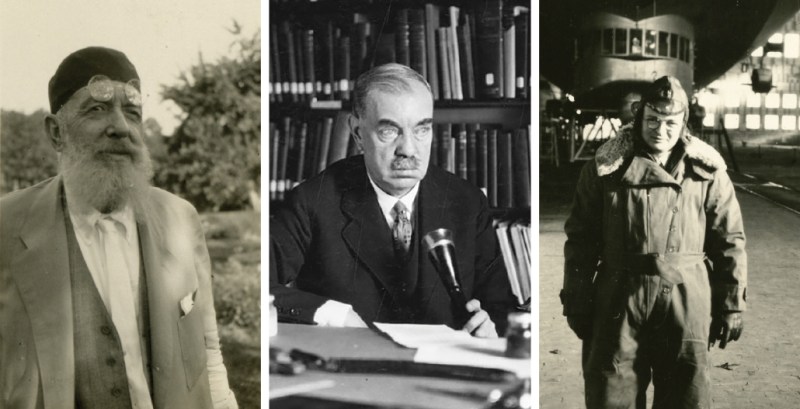
“Davis had the instincts of a journalist and an engineer’s ability to organize,” historian Marcel Chotkowski LaFollette wrote in a 2006 article about Science Service. “He could ferret out news and glean the essence from dull research reports, and proved to be a skilled manager.” Those traits served Davis well as Slosson’s right-hand man, and later as the director of Science Service from 1933 to 1966.
Science News-Letter’s earliest stories set the stage for the magazine’s coverage over the next century. Readers learned about news on the biggest scientific happenings, such as the discovery that insulin could treat diabetes, as well as curious everyday insights, such as what foods help houseflies live longer — detailed in a story charmingly titled “How to feed flies in case you love them.”
For Science Service writers, the name of the game was transforming the dry language typical of scientific papers into compelling narratives. But having staked its reputation on scientific accuracy, Science Service was careful to avoid sensationalism. Writers couldn’t risk alienating their scientist sources. Biology editor Frank Thone, for instance, once wrote a story describing insects that were “just as fond of the bright lights, a hot time and fast living” as their human counterparts — after which Thone sent a rather sheepish note to the researcher asking for forgiveness for the jazzy language.
Sometimes, Science Service’s deference to the scientific community went so far that, by today’s standards, it broke the code of journalistic objectivity. Perhaps the most striking example was Science Service’s involvement in the Scopes “Monkey Trial” of 1925, when high school science teacher John Scopes was put on trial for breaking a Tennessee law that forbade teaching evolution. Leading up to the trial, Science News-Letter printed a pledge of support for Scopes by the president of the American Association for the Advancement of Science. In another article, Davis proclaimed that anyone could see Scopes was in the right “if men will but use their eyes and their brains.”
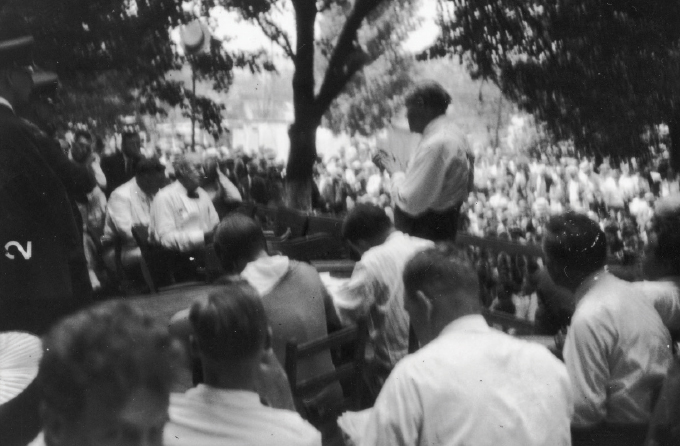
Science Service went far beyond editorializing in its coverage of the trial. The organization helped Scopes’ lawyers find expert witnesses to testify on his behalf. And when Davis and Thone traveled to Tennessee to cover the trial, they moved into the Victorian mansion that Scopes’ legal team was using as headquarters.
“All day long and far into the night, the rumble of scientific discussion and laughter issues forth from Defense Mansion,” Thone wrote, calling the place “the headquarters for the defenders of science, religion and freedom.”
From a 21st century perspective, the whole affair was completely inappropriate. But LaFollette doesn’t judge Science Service too harshly. “We must be careful in applying retrospectively contemporary standards,” says LaFollette, whose 2008 book Reframing Scopes explores Science Service’s role in the trial. The modern code of journalistic ethics was not as formal in the early 20th century as it is now, she says, and back then many journalists were more comfortable cozying up to their sources.
“Davis and Thone believed they were doing the right thing by assisting the Scopes defense,” LaFollette says. After all, in its 1921 debut announcement in the journal Science, Science Service had sworn it would “not indulge in propaganda, unless it be propaganda to urge the value of research and the usefulness of science.”
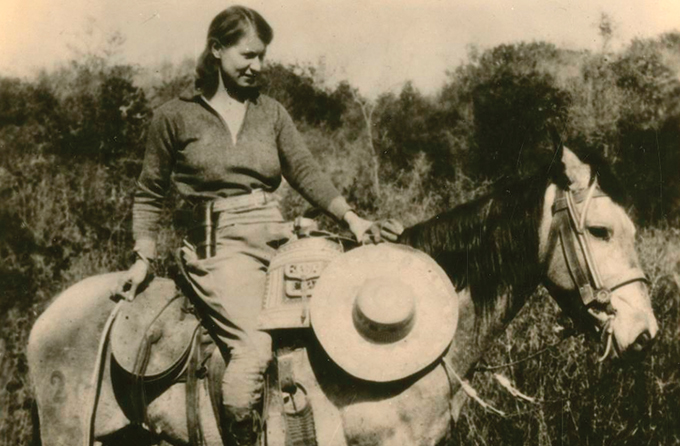
A decade after its birth, Science News Letter — which abandoned its hyphen in 1930 — had earned a reputation for top-quality, accurate coverage. Thomas Edison gave the magazine permission to print excerpts from conversations Edison had with Slosson in the twilight years of Edison’s life. In 1933, Eleanor Roosevelt reportedly commissioned Science Service to collect statistics on women working in government science jobs. And in 1936, the Science News Letter staff arranged a meeting between Albert Einstein and engineer Rudi Mandl, who was working as a dishwasher. Mandl convinced Einstein to publish a paper on a then-theoretical curiosity known as gravitational lensing. It turned out to be a very real phenomenon that today’s astronomers use like a cosmic magnifying glass to peer at the distant universe.
Throughout the 1920s, Science Service sold articles to over 100 newspapers, potentially reaching more than 7 million people. During the Great Depression, newspaper subscriptions to Science Service’s syndicated material took a hit, but individual subscriptions to Science News Letter rose steadily. The magazine kept its readers in the know about a range of fields, announcing the discovery of penicillin —which one reporter mused “may turn out to be a useful antiseptic” — and tracking the emerging field of quantum mechanics. The magazine deemed this new realm of physics both revolutionary and “disturbing.”
Science Service’s reporting was seminal in the emerging field of science writing, according to science and society researcher Dorothy Nelkin’s 1995 book Selling Science. “It laid the foundation for contemporary science journalism,” Nelkin wrote, “giving the profession both a purpose and a style.”
The war years
In 1936, Science Service helped throw one of the nerdiest dinner parties of all time.
By then, Science Service had grown to include several pioneers of science journalism, including acclaimed medical reporter Jane Stafford and psychology writer Marjorie Van de Water. “They were an extremely intelligent group of people,” LaFollette says. “If you couldn’t write quickly, think quickly, you didn’t last long in that newsroom.” But the staff wasn’t all serious all the time.
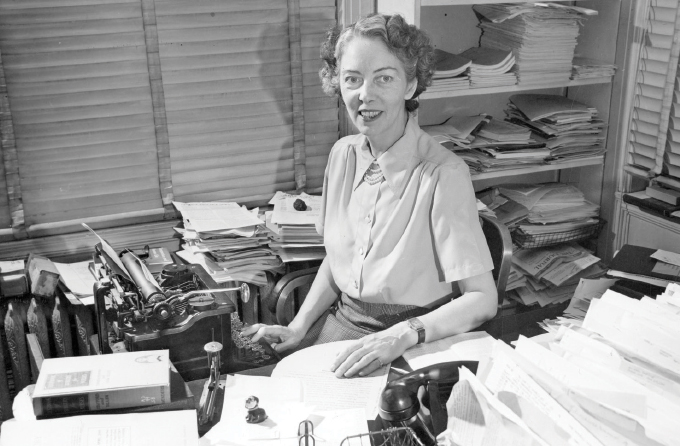
One particularly extravagant display of the team’s playful spirit was a celebration that Science Service helped organize in November 1936 honoring the centennial of the U.S. patent system. Politicians and scientists gathered in Washington, D.C., for an afternoon “research parade” hosted by Davis, where inventors showed off their various gadgets. At the banquet that followed, tables were decked out with patented hybrid flowers, and guests dined from a menu that listed the patent number for each food and drink. The entertainment featured a phonograph recording of the late Thomas Edison and a radio show broadcast from a plane flying overhead.
Science Service’s unbridled enthusiasm for the scientific enterprise was often its greatest asset. But staff members’ devotion to particular topics sometimes led to uncritical coverage. One prominent example was eugenics, a scientific and social movement in the United States and Europe in the 20th century that aimed to “improve” humankind by selectively breeding for desirable traits or breeding out undesirable ones. Such “undesirable” traits could be anything from mental and physical disabilities to supposed moral failings, such as promiscuity. Eugenics influenced U.S. immigration policies as well as laws that led to the forced sterilization of over 60,000 people in the United States.
Reckoning with past racist and sexist coverage
During our early history, Science News shared and endorsed ideas that were unscientific and morally wrong.
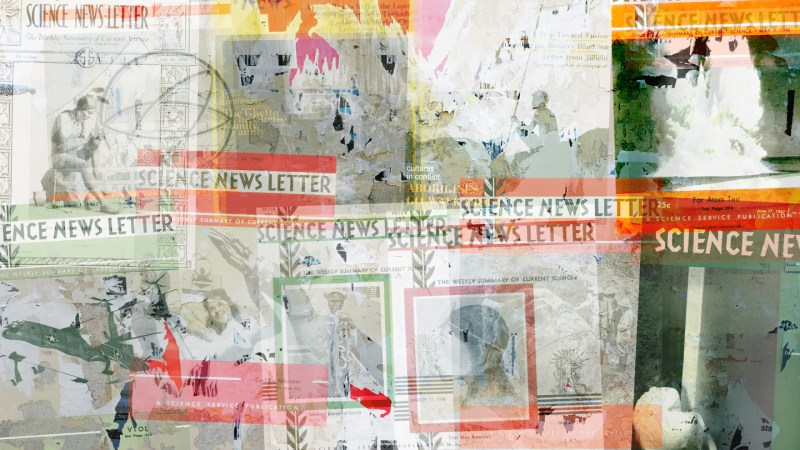
“By the time Science Service was created … eugenics had become well-established, both in the sciences and as a sort of popular political, culture and social movement,” says Emily Rader, an independent historian based in Long Beach, Calif., who was commissioned last year by Science News to provide an outside analysis of the publication’s eugenics coverage. “Science News published a lot of articles about eugenics in the 1920s and 1930s,” Rader says. That was perhaps not surprising, given that Davis was a board member of the American Eugenics Society. “There were almost no articles that brought up criticism of eugenics,” Rader says, even though some biologists and social scientists at the time had pointed out its problems.
In November 1933, for instance, the magazine published a story about American eugenicists praising Hitler’s new Law for the Prevention of Offspring with Hereditary Diseases. That law allowed the forced sterilization of several groups of people, including those who were born blind or deaf, and those who suffered from epilepsy or alcoholism. The Science News Letter article quoted an editorial from Eugenical News that said: “It is difficult to see how the new German Sterilization Law could, as some have suggested … be made an ‘instrument of tyranny.’”
Science Service’s “frequent failure to report alternative viewpoints, its gushing coverage of sterilization statutes and approving report about Germany’s new eugenics law, all suggest that the science news agency had wandered into the realm of propaganda,” Swanberg, of the University of Arizona, wrote in a 2021 article in American Journalism about Science News Letter’s eugenics coverage. If not propaganda, Swanberg wrote, this reporting was at least “not very enterprising journalism.”
Science News Letter’s eugenics reporting tapered off in the 1940s. This was around the time eugenics largely fell out of favor in the United States due to eugenics-inspired atrocities committed in Nazi Germany during World War II. There was however a slight uptick in coverage in Science News Letter in the 1960s, alongside a resurgence in eugenic ideas. (See Science News’ statement on its past coverage.)
World War II brought other changes to Science Service. Science News Letter articles touted the ways that science and engineering could aid the U.S. military. “Overshadowing almost everything else these critical days is the application of almost all our energies and our science to rescuing the world from forces of darkness,” Davis said in a speech quoted in the magazine in 1941. In a show of support for U.S. troops, Science Service began offering a pocket-sized, monthly edition of Science News Letter to service members. “This international edition,” boasted one 1943 advertisement, “will contain only the scientific news of interest to the men and women overseas.”
In the lead-up to WWII, Science News had plenty of atomic physics coverage. For instance, when physicists succeeded in splitting the uranium atom in 1939, it made the cover of Science News Letter. In the aftermath, the magazine published a slew of stories on what elements tumbled out when uranium cracked like a particulate piñata, on the prospects for using atomic energy as a fuel source or a weapon, and so on.
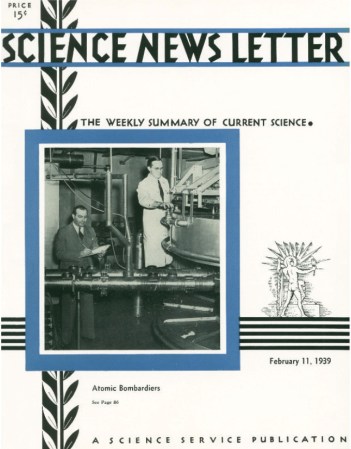
But soon, government censorship and scientific self-censorship loomed over atomic physics. “It is very improbable that if significant advances are made in the release of atomic energy from uranium, details will be made public,” Science News Letter predicted in 1940. “It will become a military secret.” Lo and behold, by late 1942 the word uranium had all but vanished from the pages of Science News Letter. When one reader sent a letter to complain about the magazine’s recent dearth of physics coverage, Davis replied that although the magazine would “like to write more about uranium isotopes and atomic power … it is not possible to do this, because of the secrecy connected with our war effort.”
That all changed in August 1945, when the United States dropped atomic bombs on Hiroshima and Nagasaki, Japan, and a government report on the Manhattan Project — the Smyth Report — came out.
“It is one of the amazing documents of all time,” Helen Davis, editor of Chemistry magazine, wrote in a letter. She was filling in for her husband Watson Davis at Science Service while he traveled. “We got two copies. One we kept intact, the other we pulled the staples out of, so we could work on parts of it all at once.” Helen Davis, along with Science Service reporters Marjorie Van de Water and Jane Stafford, spent days cranking out stories on various aspects of the report. In a letter to her husband, Helen wrote, “It is beyond all imagining. It is THE document of the age, and makes all physics and chemistry B.A.B. (Before Atom Bomb, of course) completely obsolete.”
The Second World War may have ushered in a new era of science journalism as well. “Contemporary popular science is conventionally described as having been spurred on by World War II,” Cornell’s Lewenstein wrote in a 1994 article on the history of popular science in America. “Recognizing the role in winning the war of the atomic bomb, jet engines, radar, penicillin and a host of other scientific and technological achievements, the public ‘demanded’ more information about science and technology.”
Of course, many organizations were communicating to the public about science and technology, Lewenstein adds, including science museums and journalism organizations like Science Service. “Still, it is true that the United States had people and institutions ready to participate in new opportunities for public communication of science and technology after the war.” For starters, many newspapers at the time started doing more of their own science coverage.
In 1949, Ferry Colton, president of the National Association of Science Writers — founded in 1934 by a dozen reporters, including Science Service’s own Jane Stafford — hailed Science Service as a pioneer of science journalism. The scads of science writers now working for newspapers and magazines across the country were, Colton said, “the best possible testimony to the soundness of Mr. Scripps’ judgment in encouraging popular science writing.”
But that vindication was a double-edged sword. With more science writers on staff at other publications, there was less of a need for Science Service’s syndicated material. As a result, the organization ultimately phased out its syndication effort and instead focused on producing Science News Letter, which started going by Science News in 1966. “It is like being on a first name basis,” Watson Davis wrote in the editor’s note that explained the title change, “which we like.”
In shedding its original role as a nationally syndicated news source, Science Service “doesn’t lose its legitimacy,” LaFollette says. “It retains its authority as an accurate, reliable source of news about the scientific community.” But the organization now had other priorities besides getting science into the headlines — it was getting science on the airwaves and into the hands of kids across the country.
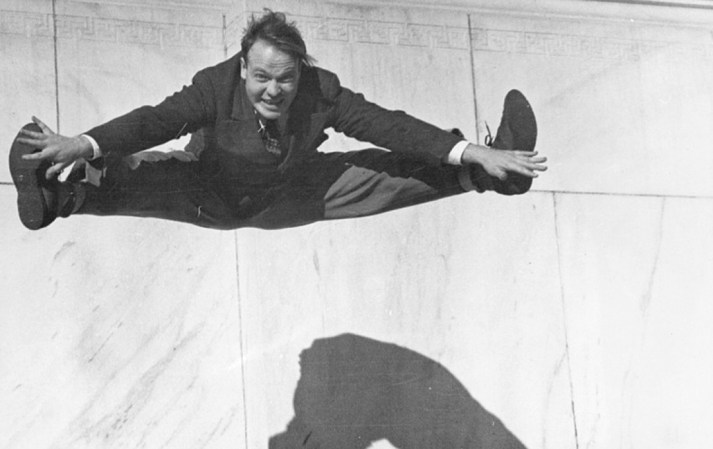
Off the page
Come one, come all, and join “expeditions to the frontiers of research!” Lend an ear as “eminent men of science tell of their own achievements!”
So opened one episode of Adventures in Science, a CBS radio program that Davis hosted for two decades.
Science Service got in on the ground floor of commercial broadcasting and was involved in radio for nearly 40 years. In the 1920s, the organization started producing weekly radio science news scripts, which were mailed to dozens of stations across the country and read on the air by local announcers. By the early 1930s, Science Service was producing the weekly news program that would soon add interviews and would come to be known in 1938 as Adventures in Science.
On the air
The CBS radio program Adventures in Science, hosted by Science News Letter editor Watson Davis (second from left in the image below), aired from 1938 to 1958 and featured interviews with scientists.
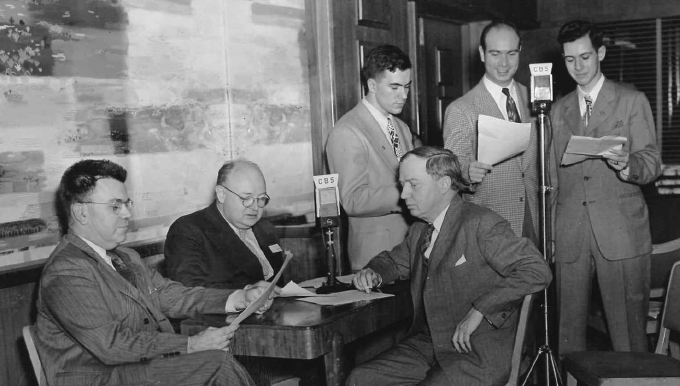
“They were attempting to use radio to do something similar to what they were doing in print,” LaFollette says. That is, get the public excited about science. But promoting science on the radio came with new challenges. Science Service often had to fight to protect its trademark scientific rigor from network executives who put more stock in making science shows entertaining than accurate. For a few months in 1938, CBS seized full control over Adventures in Science, replacing Davis with CBS announcers as hosts. That setup led to “watered-down dramatizations” of scientific discoveries and short, “almost flippant” interviews with scientists, LaFollette wrote in her 2008 book Science on the Air. The new version of the show was so unpopular it lasted only a single summer — after which CBS handed the reins back to Davis, who kept Adventures in Science on the air until 1958.
Print and radio were far from Davis’ only tools for promoting science. “He was a tremendously creative guy,” Lewenstein says. And one of Davis’ most successful out-of-the-box ideas was Things of Science.
The Things of Science program mailed experiment kits in small boxes to children, schools and science clubs around the world. Every kit contained some scientific goody, such as a fingerprinting kit, flexible magnet or silkworm cocoon — including some Things of Science products that definitely wouldn’t fly today, like asbestos-containing fabrics. Each bit of paraphernalia came with a little placard to display the item. “In a short time,” promised one 1957 flyer, “you will build up an extensive and unique little science museum of your own.”
MIT signal processing researcher George Moody recalled saving a quarter each week for four months to buy his subscription as a child in the 1960s. “I suspect that many of us who chose careers in the sciences found at least part of our inspiration in those blue boxes,” Moody wrote in a blog post about an online Things of Science catalog he created.
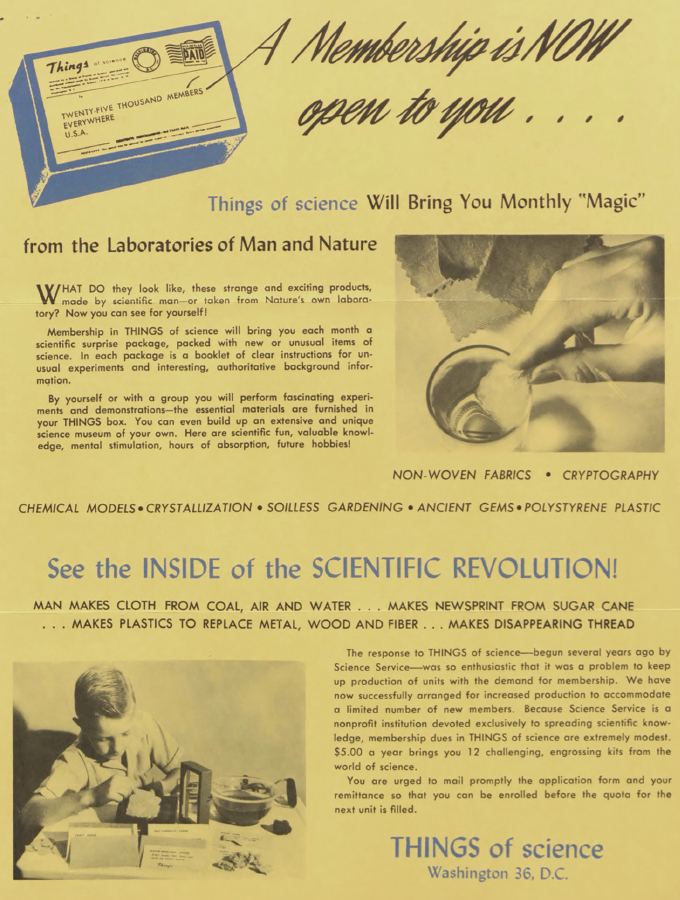
The Things of Science program launched in 1940 and ran for decades. Around the same time, Science Service undertook another major effort to encourage the next generation of scientists: The organization started hosting science competitions for science-minded kids around the country — and later the world. It all started in 1942 with the first annual Westinghouse Science Talent Search, now called the Regeneron Science Talent Search, for high schoolers. In 1950, Science Service kicked off a second annual competition that has grown into the Regeneron International Science and Engineering Fair, which draws high school competitors from across the globe. And since 2010, middle schoolers have competed in the annual Broadcom MASTERS contest.
Amid all these other ventures, Science Service continued mailing out copies of Science News — which also played a role in inspiring young minds. The magazine was a natural fit for student readers, says Barbara Culliton, who covered life sciences for Science News from 1966 to 1971. “There’s a lot of explanation of the mechanisms of how things work,” she says. “That is a formula that speaks particularly to people who want to learn something.”
Joseph Bates of Newton, Mass., remembers reading issues of Science News when he was growing up in the 1960s. “They gave me the sense of science as a search for truth,” he says. “You really had a feeling of the liveliness of scientific inquiry.” Watching the drama of science unfold in real time helped Bates envision himself as a scientist. Bates became a computer scientist, and in 1992, Science News covered his research on how to build lifelike characters in virtual reality.
To help younger readers connect with the coverage, Science Service launched a second publication in 2003. The online magazine Science News for Kids — now Science News for Students — covers a similar range of topics as Science News, but is written at a middle school reading level.
“Kids shouldn’t have to work to understand our stories. They should read them because they love them, and because it explains their universe,” says Janet Raloff, who started writing for Science News in 1977 and has helmed Science News for Students since 2007. “They’re just sponges trying to understand all this cool stuff.”
Andrea Distelhurst, a high school biology teacher in Bradenton, Fla., has used both Science News for Students and Science News with her students. “We try to impress upon them that science keeps changing over time,” Distelhurst says. Science News gives the teenagers a front-row seat to those changes.
Calling all kids
The online only Science News for Students covers stories similar to Science News but written at a middle-school reading level. After its launch in 2003 as Science News for Kids, the site published just one feature story and two short news items per week. And the news stories were always Science News articles rewritten for younger readers. But in the years since, the offerings have expanded to include more kid-friendly content, with stories on topics like adolescent health and gaming, as well as comics, explainers and guides for at-home science experiments. The goal, says Janet Raloff, editor of Science News for Students, is “to make sure we have something for everyone.”
-

The Experiments series is meant to teach students of all ages about how science is done. An experiment on rock candy tests how much sugar you need to make the sweet treat. KTAYLORG/ISTOCK/GETTY IMAGES PLUS -
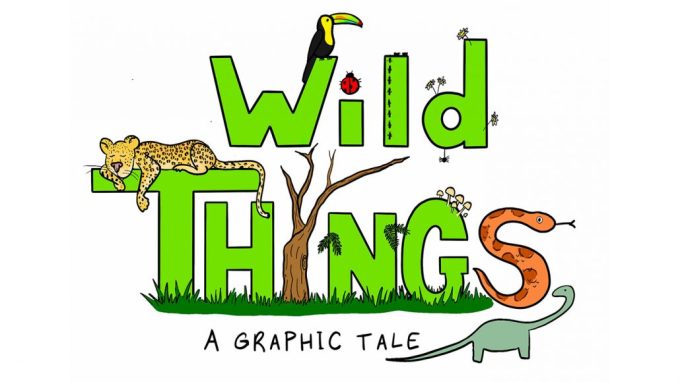
Wild Things tells stories of science through comics. One comic depicts how goldfish driving “cars” offer insights into navigation; another shows how cockatoos learn to open garbage bins. JOANNA WENDEL -
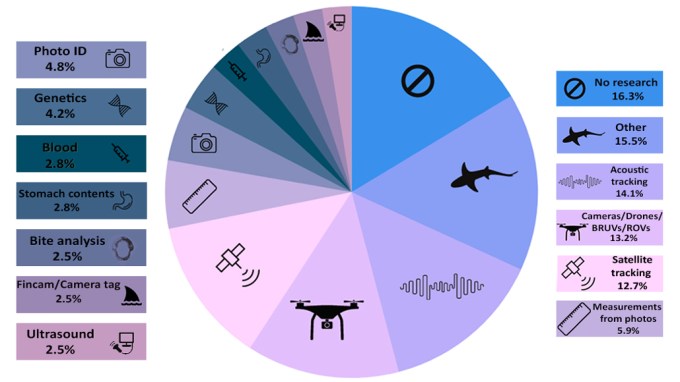
Analyze This explores science via data and graphs. This visualization captures the variety of research methods featured on more than 200 television shows aired during Shark Week. JULIA SALTZMAN; ADAPTED BY L. STEENBLIK HWANG -
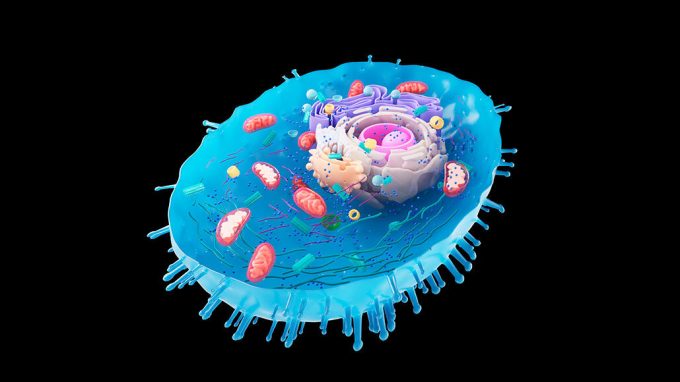
A eukaryote (noun, “Yoo-CARE-ee-ote”) is a living thing whose cells contain a nucleus, reports Scientists Say, a weekly series that defines a scientific term and puts it in context. SCIEPRO/SCIENCE PHOTO LIBRARY/GETTY IMAGES -
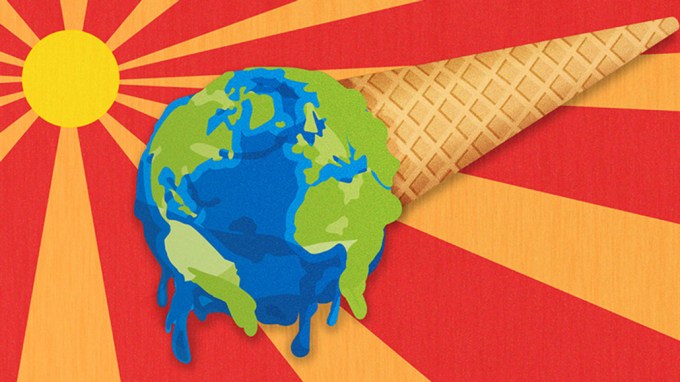
Science News for Students spent a year documenting climate change around the globe in its Climate Change Chronicles. MYILLO/ISTOCKPHOTO, ADAPTED BY E. OTWELL
On the beat
In 2011, Science News editor in chief Tom Siegfried assigned Raloff a herculean task. Over the next year, he wanted her to scour every past issue of Science News and compile a list of the most important stories from each decade to commemorate the magazine’s 90th birthday.
Undaunted, Raloff started carrying bound volumes of old print magazines home from the office on weekends and vacations. “In a beach house, I was going through all these volumes, taking notes,” Raloff says. “My family thought I was crazy.” But Raloff rose to the challenge, reading more than 70,000 pages of Science News in a single year.
Her assessment? “We did very catholic coverage across all of the disciplines,” she says. But over time, different scientific fields took the spotlight.
In the 1960s, all eyes were on the space race. But earthly issues came to the fore in the following decades, as public concerns over the environment mounted. Science News covered the U.S. Environmental Protection Agency’s announcement that it was outlawing use of the harmful pesticide DDT and the signing of the global Montreal Protocol to phase out ozone-destroying chemicals. In the 1990s, growing agreement among scientists about human-caused climate change shifted environmentalists’ focus toward cutting carbon emissions. Amid a surge in molecular biology research, Science News explained how scientists become masters of manipulating DNA — creating synthetic genes and accomplishing other feats of genetic engineering in the 1970s, and then deciphering the human genetic instruction manual, or genome, at the turn of the century.
Whatever the hot topic at any given time, Science News didn’t let other fields slip through the cracks, says Julie Miller, who covered life sciences for the magazine from 1976 to 1986 and returned as editor in chief from 1995 to 2007. “You have so many people enthusiastic about their own fields that there’s always some coverage across the board,” she says. Miller recalls an old journalism professor visiting her at Science News headquarters and noting, “It’s like you’ve got a little university here with just one person in each department.”
Joel Greenberg, editor in chief from 1981 to 1988, had a similar feeling about Science News staff. “The writers and editors were just so invested,” he says. “They just lived their beats.”
Perhaps no one embodied his beat more fully than Jonathan Eberhart, who covered space science and exploration for Science News from 1960 to 1991, including the Apollo 11 moon landing. Eberhart was such a dedicated reporter that he moved to Pasadena, Calif., for several months during the Viking mission to Mars so he could report new findings directly out of NASA’s Jet Propulsion Laboratory.
“He was so curious and so smart and had such great questions that they loved him and almost accepted him as a member of their team,” says Kendrick Frazier, who was the Science News editor in chief at the time. “That contributed to the quality of his articles.” Those articles won Eberhart the American Association for the Advancement of Science and Westinghouse Corporation’s joint science writing award in 1976.
Science News staff did on-the-ground reporting for other major scientific events, too. Thone, for instance, witnessed the nuclear tests at Bikini Atoll in July 1946. And Raloff visited the Three Mile Island nuclear power plant after its historic meltdown in 1979.
Science News reporters also got many of their story ideas from scientific meetings. “The meetings we went to were where cutting-edge papers were presented,” Greenberg says, “so we’d get in on the ground floor on all of these new developments.”
Miller still vividly remembers one such meeting. It was a gathering of medical researchers in 1981 — just after the first cases of acquired immunodeficiency syndrome, or AIDS, had appeared in the United Sates. “The scientists there were running around, all upset about this cluster of diseases that were occurring in gay men, and they put together a symposium on the spot,” Miller says. “I came back and said we had to write about this.” As the AIDS outbreak became an epidemic, Science News followed the quest to develop tests and treatments.
There were “so many parallels to what’s going on now with the coronavirus,” Greenberg recalls, “including a guy we quoted a lot back then in the search for a cure for AIDS. A guy named Anthony Fauci.”
Some meetings offered Science News writers a brighter glimpse of the future. Ivars Peterson, who covered math, technology and other physical sciences from 1981 to 2007, recalls one particular gathering of physicists in the 1990s. “I saw this amazing thing called a Web browser,” he says. “I was blown away.” Other meetings granted Peterson access to more offbeat scientific curiosities — like a meeting of engineers who had given the Statue of Liberty a makeover in the 1980s, which ended with a private tour of the renovated statue.
That mix of big, flashy findings and more obscure advances won Science News the 1987 George Polk Award for excellence in science reporting. In his nomination letter, New York Times science writer Malcolm Browne wrote, “I can’t imagine any significant development in science, however arcane the discipline, escaping the speedy notice of Science News.”
On the scene
Science News reporters go where the science is, doing on-the-ground reporting of major scientific events, getting into the lab and attending scientific meetings.
-

Astronomy writer Lisa Grossman suited up to enter the clean lab at NASA’s Johnson Space Center in Houston. FELIX SANCHEZ -
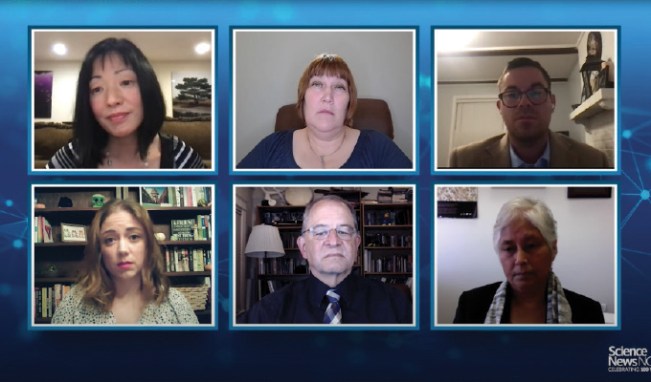
Members of Science News’ pandemic reporting team interviewed experts on COVID-19 science on Zoom in 2021. SCIENCE NEWS NOW -
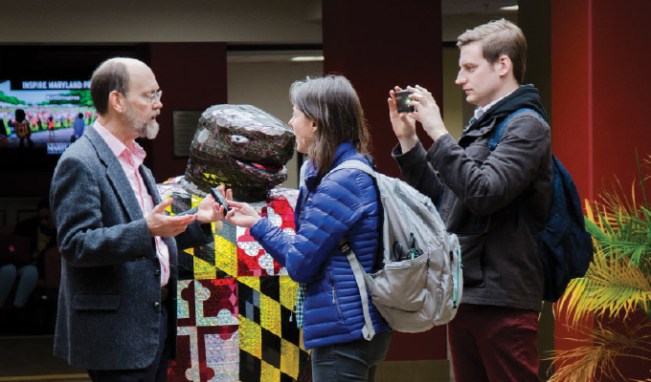
Biomedical writer Aimee Cunningham and audience engagement editor Mike Denison interviewed environmental health scientist Donald Milton on influenza’s spread on a college campus. UNIV. OF MARYLAND SCHOOL OF PUBLIC HEALTH -
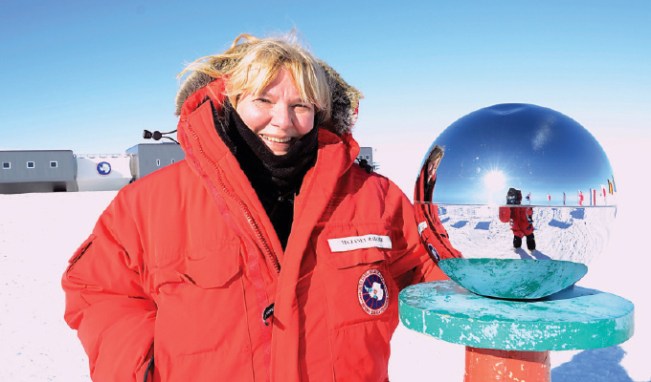
Janet Raloff reported from Antarctica in 2012 on the southernmost active volcano, Mount Erebus. NSF
All about the science
Science News staffers — past or present — often describe their readers as science buffs.
“We reported on increments that were much smaller than any newspaper or other publications,” Greenberg says. Naturally, that attracted readers who were “interested in every nook and cranny of science.” Some were scientists keeping up with the latest in other fields. Others were plain-old science enthusiasts.
“There is an eclectic mix in there,” says Raloff, who has received reader letters and phone calls from farmers, motorcycle mechanics and artists alike. But Science News readers have always been united by one common feature, she says: “People who just loved science and wanted to get their fix of what’s new this week.”
Science News staffers have typically been science buffs themselves. And that has influenced the kinds of stories that the magazine tells. Historically, Science News has focused more on regaling readers with new discoveries, Lewenstein says, than, say, investigating the motivations of those who fund certain research projects.
John Travis agrees. He covered biology for Science News from 1995 to 2004 and is now the managing news editor at Science, an academic journal that also covers news in science. “At Science, we cover policy, we cover the community, we cover the failures and weaknesses of scientists,” he says. Science News has given those topics less attention.
Over the years, Science News has pondered some thorny ethical questions surrounding new science. When the first heart transplant was performed in 1967, for example, Science News covered surgeons’ concerns about whether it was moral to save one person’s life using a treatment that relied on someone else’s death. In 1975, the magazine covered a meeting about how genetic engineering could be regulated to prevent scientists from spawning unnaturally dangerous bacteria in the lab.
But, historically, such stories have not been the main focus for Science News. “For better or for worse,” Travis says, “they focus on the curiosity and wonder of science more than the downsides of it or of the scientific community.”
There was good reason for Science News’ “very pro-science” attitude, Peterson says. “Science is a very useful way of looking at the world.” But that didn’t necessarily mean the magazine hailed every reported result as a breakthrough, he adds. “We were always very careful to put in what the scientists like to put in,” Peterson says, “which is the ‘maybe’s’ and the ‘with a high probability,’ to avoid overstating things.”
Travis remembers applying that skepticism when he covered the announcement that two research groups had completely mapped the human genome in 2000. “I was so annoyed at the press conference,” Travis says now. The epic mapping project wasn’t actually finished. Neither group confirmed that its genetic sequence was free of gaps or errors — and in the opener for his story, Travis pulled no punches: “Biology’s hottest race has been declared an amicable tie,” he wrote, “even though one competitor has a clear lead and neither has actually reached the finish line or knows exactly what the prize contains.”
That sober perspective would probably have made Davis proud. While director of Science Service, Davis drafted a list of “Stories That Should Be Handled with Care,” from reports about the healing powers of hypnotism to long-range weather forecasts to “sweeping claims of any sort.”
Science News hasn’t always perfectly applied that critical eye, as Raloff discovered in her 90-year review of the magazine’s coverage. “There’s a series of those things,” she says, “where you just look at them and you go, ‘Oh my god. How could we ever have covered that, just straight-faced without challenging it?’” Raloff was particularly shocked by a Cold War–era article about a proposal to excavate a new Panama Canal with nuclear explosives. “We covered it like … ‘Isn’t that a clever idea?’” she says. “No! It’s a horrible idea! You’ve just gone through World War II. How could you think that’s a good idea?”
The problem with those kinds of stories, Raloff says, was often that writers reported on bold claims without including comments from other researchers in the field. Seeking comments from outside experts to provide perspective and criticism has now been standard practice at Science News for decades. “It’s kept us from having egg on our face, I think, in some of our contemporary coverage,” Raloff says.
Kevin Parker of Greenbelt, Md., who has been reading Science News since 1969, appreciates that approach. While other publications have “a tendency to do kind of the print version of clickbait,” he says, Science News stories usually “manage to keep an even temper.”
The magazine has always put a premium on factual correctness in stories. “There was a lot of care taken to make sure things were accurate,” Peterson says. “It would screw up once in a while, but that was rare.” One 1985 article, for instance, reported the discovery of a lost city in Peru that was not, in fact, lost at all, but had previously appeared on maps and in guidebooks. Science News published a follow-up story acknowledging and correcting the error, just as an editor’s note appears on corrected stories today.
“Reporting without sensationalizing and getting things right,” Frazier says. That has always been and continues to be the Science News brand. “It’s a quality, reliable, respectable science news source.”
Going digital and beyond
A popular science magazine may have been a niche product when Science News-Letter got its start, but half a century later, Science News was far from the only game in town. The 1970s and 1980s brought a flurry of new science magazines. Many of those publications ultimately folded because they couldn’t sell enough ads, but Science News survived on the support of its subscribers.
“It seemed to have a really devoted following,” says Richard Monastersky, who covered earth sciences for Science News from 1986 to 2000. “The people who got us really loved us.” Hollywood icon and Science News subscriber Marlon Brando, for instance, sometimes called Science News reporters to discuss stories that piqued his interest.
Greenberg recalls meeting Science News readers from California after he had left the magazine in 1988 to become a science editor at the Los Angeles Times. “I’d get on a plane, and there’d be somebody from JPL or Caltech, and they’d say, ‘What do you do?’ and I’d say, ‘I’m a science editor at the LA Times,’ and they’d … go back to reading or something. And then I’d say, ‘But I used to be the editor at Science News,’ and they would drop everything,” Greenberg says. “It was like I was a matinee idol or something. They’d just want to talk and talk … they couldn’t care less about any newspaper stuff, but they really were devoted to Science News.”
Such dedicated readers were the key to helping Science News thrive in the 1980s. But in the 1990s, Science News faced a whole new wave of competition online.
Science News launched its website in 1996, the same year that Scientific American and the New York Times went online. Each week, the Science News website posted short summaries of every story in the magazine and the full text of at least three articles. Raloff’s food science column “Food for Thought” and Peterson’s “MathLand” were among Science News’ first online-only content. But Science News’ print magazine was still the mainstay of the operation; the website was just a bonus.
Not every staff member was sold on the staying power of the internet. In her final editor’s note of 1996, Miller expressed her skepticism. “Will the Web evolve into the New Media, as Wall Street analysts proclaim, replacing television, newspapers, and other sources of information and entertainment?” she wrote. “Maybe, maybe not.”
“How could we have been so naive!” Miller says now. “We were about to get run over by this train, and we were thinking, ‘Maybe it will come, maybe it won’t.’”
Of course, as it did for everyone, the internet changed everything for Science News. “For the kinds of people who read Science News,” Lewenstein says, “suddenly, you don’t really need Science News.” Online readers had all kinds of publications to read for free, and scientists could speak directly to the public on their own websites.
When Siegfried became editor in chief of the magazine in 2007, his mission was to help Science News stay relevant in the digital age. “It was a recognition that online news was becoming a dominant force,” Siegfried says. “The online publication was a way to increase the timeliness, to reach out to more people and to … create general awareness of the magazine and try to boost circulation that way, too.”
To that end, Science News started posting news online every day and collecting the most important stories into a biweekly magazine. Going to print every two weeks, rather than weekly, allowed the newsroom to focus on more rapid online coverage and to produce a heftier magazine for each print issue, Siegfried says. “That was a big change in how things were done.”
By operating as a daily news outlet, Science News could jump on new discoveries faster. In 2012, Science News broke the discovery of the Higgs boson a day before scientists made their official announcement, thanks to then-editor Kate Travis, who uncovered an announcement video accidentally posted early on CERN’s website. In 2019, Science News published a story about the first image of a black hole mere minutes after it was unveiled. That article drew over 1.5 million unique page views in a single day — a nice achievement for a publication believed to be the first to use the term “black hole” in print, in 1964.
Despite Science News’ growing online audience, print circulation was dwindling. “We were like all magazines or newspapers, in that we had survived on advertising and subscribers,” says Maya Ajmera, who became president and chief executive officer of the Society for Science and publisher of Science News in 2014. “That model completely changed.”
Ajmera sought new funding from private donors and foundations, and launched the Science News in High Schools program to boost print readership. (Science News in High Schools provides educators at more than 5,000 schools print copies and online access to the magazine, along with other classroom materials.) Those changes have helped make Science News more financially sustainable, Ajmera says, with more than 21 million visitors to its main website in 2021. “I’m excited by the next century of Science News.”
The century ahead
Today, Science News is aggressively covering some of the biggest stories of our time, including rapid new developments in the COVID-19 pandemic and the global crisis of climate change. Reporters have their eyes on game-changing technologies across all fields, from gene-editing tools that could cure diseases to quantum computers that promise to perform feats of calculation impossible for normal computers. But, true to form, the magazine also serves up the lighter side of science, explaining why wombats have cubed poop and what gravitational waves from a wormhole might look like.
“I’d also love to see more stories that are dealing with the human condition,” Ajmera says. She points to reporting by social sciences writer Sujata Gupta, who has covered research on police reform and how the pandemic has worsened some socioeconomic inequalities. “How do we produce more stories that can really touch everyone’s lives?” Ajmera asks. “I think we can do more.”
Editor in chief Nancy Shute thinks so too. When Shute came to Science News in 2018, she says, “I thought it would be really important to expand our social sciences coverage to help people see how science could help them understand what’s happening to them and what’s happening to the world right now.” Part of that was bringing on Gupta to cover social sciences. But stories in other fields can elucidate people’s personal connections to science, too. Shute is especially proud of a series that Tina Hesman Saey took on before the COVID-19 pandemic. “Genetic testing goes mainstream” explored the uses and limitations of direct-to-consumer DNA testing for medical information and tracing ancestry.
“It was a great example of explanatory science journalism that people could really engage with, because it directly impacted their lives,” Shute says. “That’s a great example of the superb work that Science News can do.” In fact, the series won a 2019 National Academies of Sciences, Engineering and Medicine Communications Award.
Shute also hopes to captivate more readers with new types of storytelling. For a century, the written word has been Science News’ bread and butter. But that form has its limitations. “Online journalism is a visual medium,” Shute says, “and it’s really important that we invest more in that.” She would like to produce more data visualizations akin to one that Science News developed last year to illustrate every cosmic collision known to have kicked up gravitational waves.
“It was so creative,” Shute says. “Being able to do things like that, and give people another way to explore the science that’s scientifically accurate but also incredibly fun and can deliver surprises, is just a joy.”
That’s really what science journalism is all about, says Laura Helmuth, who interned at Science News in 1999 and is now editor in chief of Scientific American. “The fundamental goal [is] making the most important research accessible and engaging and entertaining and fun to read,” she says, which has been the purpose of Science News from the start. “I think that sticking with that principle has really been the reason it’s survived and thrived.”
In May 1921, just one month after Science Service was born, Ritter wrote a letter to his old pal Scripps. In it, Ritter expressed his optimism that Science Service’s journalism would meet an eager audience. “Unquestionably there are aspects of science that appeal strongly to popular interest,” he wrote. “There is much that is curiosity-satisfying, much that is practically useful, much that is dramatic.”
Indeed, the last 100 years have revolutionized scientists’ understanding of everything from the architecture of the atom to the size of the universe. Through it all, Science News has tried to shine light on as many corners of science as possible. It is, as Shute says, “everything you need to know about science, including things you didn’t know you wanted to know.”







